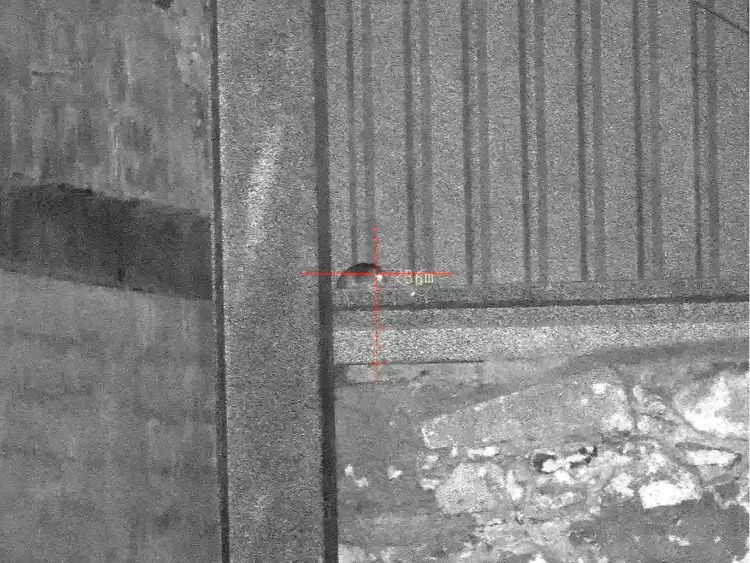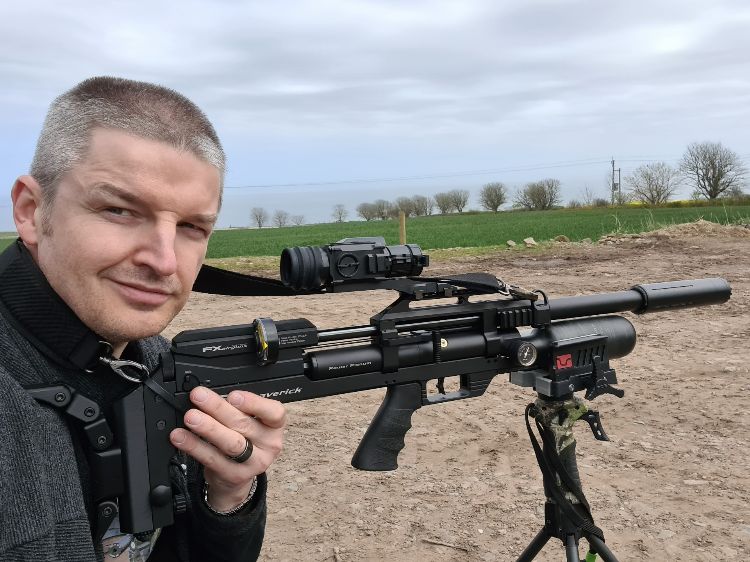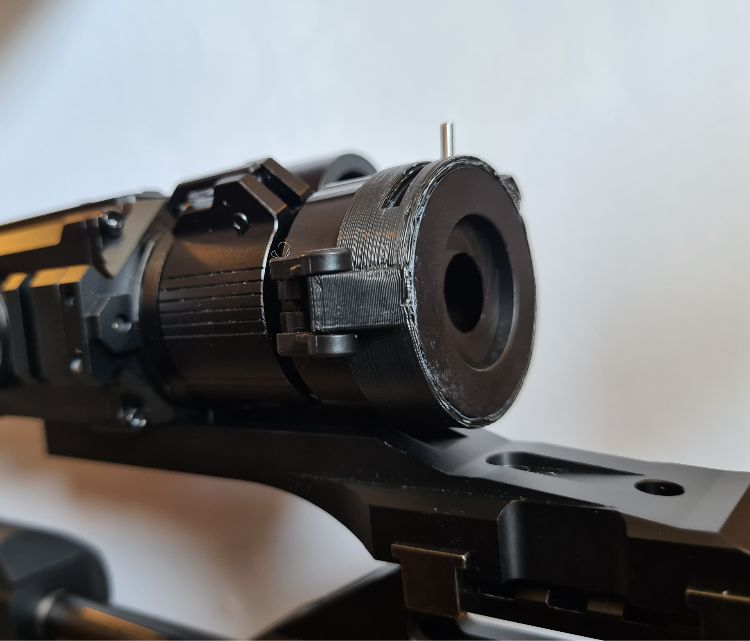Back in February, I filmed an exclusive preview video on the PARD008S-LRF scope on the Sportsman Gun Centre (SGC) stand, at the British Shooting Show. Well, I was patient (honest), and I finally bought and received my own scope at the start of May.
I’ve owned two older 008-LRF models for several years and they’re my go-to scopes for day and night pest control. No, the daytime clarity’s not as good as a (glass) day scope, but for compact portability and all-in-one functionality I feel they can’t be bettered, especially with HD recording and night-vision (NV) capability.
With my mobility issues the size/weight (or lack thereof) of my rifle/scope combo is invaluable to me, so having such a compact and light scope literally brimming with features is fantastic. Pard just lifted those features to whole new levels with the latest model(s).
Redesigned
The entire scope body has been redesigned and improved, now lower-profile and altogether sleeker. There’s now a hanged lens cap and neat pop-up hinged objective lens focus throw lever. The standard model is the PARD008S, which includes an infrared (IR) illuminator, adjustable for both beam size and strength. That comes as standard in 850nm wavelength, although is also available to order in 940nm, for those pest controllers whose prey is particularly skittish, with almost no visible IR illuminator lens glow at night.
The higher spec PARD 008S-LRF adds to that not only a compact onboard laser rangefinder (LRF), but also incorporates the integrated ballistic calculator software. The older model’s much-derided Picatinny mounting adaptor has been upgraded and although cosmetically looks the same, albeit slightly broader, I feel has also been improved, more on that in a mo’.
One omission for our market is that the UK spec’ firmware deactivates the inbuilt visible red laser designator, presumably at the request of Trading Standards, as before.
 PARD NV008S-LRF improvements
PARD NV008S-LRF improvements
External
The general layout follows on from the older (pre-P) Pard008-LRF, with which I’m very familiar, having used it day and at night for many years. That obviously helped me to get up and running here, although the controls are pretty straightforward. Externally, the LRF module is now smaller/sleeker, and moved over to the left side, and the IR illuminator is tucked below that. I’m still deciding whether or not I prefer it there, but it functions the same, with a front lens collar that can be slid forward or back to concentrate or broade the beam, and three power levels (plus off), controlled by the third button. Speaking of controls, the four buttons are very similar to before, although slightly lower profile, so perhaps not quite as easy to differentiate by touch alone, e.g., with gloved fingers.
The memory card/USB-C compartment is on the right side as before, again improved, and here with a central finger-friendly cap, so no more scratching the external finish when opening the slotted cap with a 20p piece. The overall finish is very smart with sharp black anodising. There’s also now virtually no audio interference recorded on videos whilst the LRF is ranging, and a low battery now causes no such similar interference. That – due to insufficient internal electronic shielding – was a huge bugbear of mine on the earlier models, with me recording for YouTube. Objective focusing is still quite focus-fussy, but that’s an issue inherent with optics of this design.
Internal
The new colour menu is easy to navigate, and zeroing is as before, with five zeroing profiles and six reticle designs – plus no reticle, for spotting – available in red, white, yellow or green. The BCL supplemental reticle is available in three designs: ‘X’, ‘—’ and ‘[ ]’, unusually in yellow, blue or green (i.e., different colour options). One hiccup I spotted is the BCL reticle records on video as white, regardless of the colour I selected to aim with, I fed this back to SGC to report to Pard for improvement.
The huge improvement on the 008S-LRF is the inclusion of a ballistic calculator, (note: I’m using ‘BCL’ to differentiate from the existing BC, which as you know stands for Ballistic Coefficient, an important factor here). You don’t have to activate and use this feature but take the time to do so and you’ll be rewarded with an awesome bonus.
 Testing the PARD NV008S-LRF
Testing the PARD NV008S-LRF
I had to put the scope and particularly the BCL facility through a thorough test both for reporting back you, and to use it with confidence during actual pest control, which I’ve already done twice this week. There’s a new menu option for ballistic calculator, where you can set the seven BCL parameters for your chosen reticle. They are:
|
Profile ID
|
|
|
Velocity
|
|
|
Bullet wt (g)
|
Definitely uses grains, not grams.
|
|
Bullet BC
|
Found on the pellet tin, or if not, search online.
|
|
Altitude
|
Not particularly significant in this country.
|
|
Temperature
|
Ditto.
|
|
Scope Ht
|
Distance from scope LOS to bore.
|
|
Zero range
|
|
All can be set in imperial or metric units and are pretty standard, although there’s no G1, G2 … option for projectile drag coefficient, which some may be familiar with from using firearms ballistic Apps.
With my .177” FX Maverick already zeroed at 30m and all the data input, I wanted to check how well the BCL compensated for different ranges. It was a windy day, so I set up my MTM High-Low shooting table indoors within the sheltered empty grain barn.
Select your zero profile and corresponding BCL profile, then press the LRF button once to start ranging, and again to stop once you’re happy you’re ranging the right spot. At that point the BCL superimposes your chosen supplemental aimpoint (I chose a blue ‘X’), with calculated holdover/holdunder, over your pre-zeroed reticle with the distance displayed to the right of the aimpoint. Another press of the LRF button clears the BCL aimpoint.
Starting with a full group at 30m to settle down my pulse, I then moved it back to 36m, before closer at 23m, 19m, 10m, 7m and 3m. See the target photos for the results, including the overestimated BCL (by 20mm) at 3m. Hence my preferred reticle is number 3 with the numbered sub-tensions, so at close ranges I can aim with them rather than the incorrectly placed ‘X’.
Is it perfect?
‘Not yet’, is the answer here, although the firmware has already been improved and updated since it was launched in February, when there were some minor hiccups like the displayed BCL aimpoint not appearing on video recordings.
I see other 008S-LRF users daily on the forums having great successes using the BCL at various ranges, but as you’ve seen from my own thorough testing, I discovered there are still minor inaccuracies at very close ranges. I know many shooters wouldn’t notice these, especially if they generally engage pests beyond 10m, for example, but from experience I knew I also needed the BCL to work very close indeed.
I’m sure the short-range BCL issues will doubtless soon be fixed by a firmware update. My only slight complaint is the LRF’s horizontal laser ‘splash’ (visible in NV mode) is significantly larger and sloppier than the narrow/sharp vertical one of previous models.
Close focus range
I’ve taken advantage of the scope’s close focus range twice this week, when clearing feral pigeons from old sheds. I first spot them with my thermal spotter as usual, sometimes sidestepping to avoid a roof timber and confirm a suspect ‘glow’. Here at times, I’ve leaned against stone walls or rested my forearm on stone window ledges to keep my balance, then have been aiming upwards at 45 degrees, not easy or comfortable thanks to my broken neck.
The closest I’ve ranged birds has been three metres on one occasion. In each case, I’ve been as quiet as possible and used no light to avoid spooking the pigeons. The silent buttons and invisible beam of the LRF allowed me to range each bird quickly and quietly. Then, once the BCL aimpoint appears, I overlay it on my target, only pausing to correct the overestimated holdover by aiming with the numbered reticle’s stadia at very short ranges, as learned from my indoor testing.
 Optional extras
Optional extras
These scopes are pretty much all-inclusive, although I have purchased a finger-adjustable Shader8 (adjustable iris) from Ash at Custom Hunting, which adds only a negligible 10g of weight. These are fitted using a 1.5mm Allen key and directly replace the scope’s hinged plane lens cap. I’d say they’re very useful additions for any digital scope used in daylight, where I’ve experienced several suffering a ‘washed-out’ image from too much direct sunlight.
The downside is the objective lens diameter, reduced from 29.6mm to 22.7mm, which can significantly reduce light ingress at dawn and dusk. Plus, I’ve rotated mine through 180 degrees, by loosening the Pard lens hinge clamp, so the iris’ operating lever points downwards. That was after finding while reaching over to adjust the objective lens’ focus throw lever in use, I kept catching the iris lever and dimming the image – lesson learned. For dedicated night sessions, I’ll loosen the clamp and remove the Shader8 altogether, to keep everything simple.
The other item will be re-fitting the scope via the EagleVisionCam 108MOA fully adjustable mount ASAP. Although I’ve found the zeroed scope reticle is now perfectly centred, thanks to the Maverick raiser rail’s inbuilt 20MOA incline – so the windage and elevation ‘pre-zeroing’ facility isn’t required – the scope rail on my FX Maverick is a little on the short side.
Once design whizz, Masood, launches the alternate upper Picatinny rails for these excellent mounts, I’ll re-fit my scope with this. At that point I can take advantage of the mount’s adjustable ‘reach-back’ position, to get the scope eye-cup in the perfect position without moving it off-centre via the mount’s screws. The alternate top rail is required because the underneath mounting ridge that accepts the Picatinny adaptor is 1mm wider than on previous Pard008-series scopes, so my existing 108MOA adapters aren’t compatible.
Conclusions on the PARD NV008S-LRF test
On Monday night, I sat down within a pitch black barn and shot a family of five rats against the far wall, at 36m, with no problem at all, ranging them, then aiming with the BCL reticle. Stepping outside, I then leaned in through the opening of a derelict barn, before ranging and shooting four feral pigeons overhead from 8m to 22m.
The footage from those first night sessions is a little grainier than I’d usually like for broadcast, but providing I can see enough to distinguish my prey and aim, I decided to keep the IR illuminator’s power as low as possible, to avoid spooking my prey with the tell-tale red lens glow. As my experience with this scope grows, I’ll up the power (and clarity), as well as trying various LED and VCSEL IR torches.
Sorry if I’ve crammed a lot into this review, but this scope has definitely improved upon existing versions, and is packed with features. I also have so many more articles to bring you that I couldn’t afford to stretch this piece over two issues.
Kit used
PARD008S-LRF: £899
Visit Sportman Gun Centre
Pard008S-LRF adjustable iris sunshade: £19.99
Visit Custom Hunting
MTM High-Low shooting table
Visit John Rothery Wholesalers